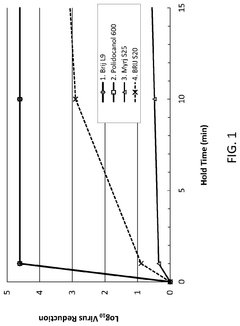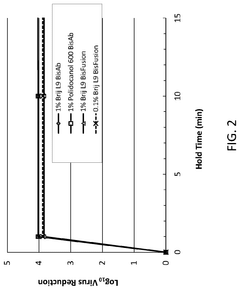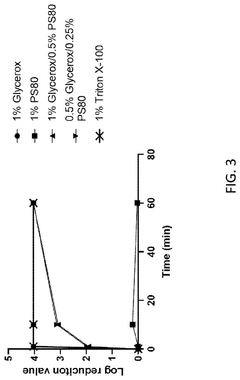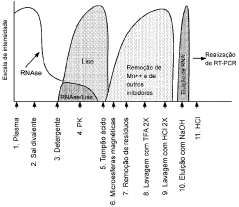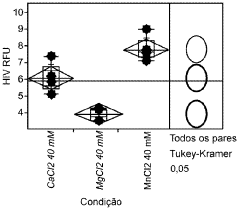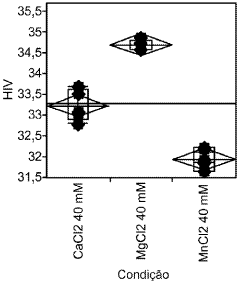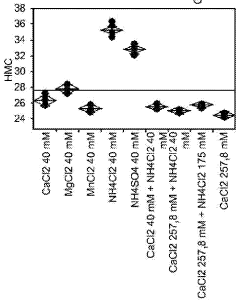Triton X-100 and Its Impact on Antigen-Antibody Interactions
JUL 31, 20259 MIN READ
Generate Your Research Report Instantly with AI Agent
Patsnap Eureka helps you evaluate technical feasibility & market potential.
Triton X-100 Background and Research Objectives
Triton X-100, a nonionic surfactant, has been a cornerstone in biochemical research and industrial applications for decades. Discovered in the 1950s, this versatile compound has revolutionized various fields, particularly in the study of antigen-antibody interactions. Its unique molecular structure, consisting of a hydrophilic polyethylene oxide chain and a hydrophobic aromatic hydrocarbon group, enables it to effectively solubilize proteins and other biomolecules without denaturing them.
The evolution of Triton X-100 usage in scientific research has been marked by significant milestones. Initially employed as a general-purpose detergent, its potential in immunological studies became apparent in the 1970s when researchers observed its ability to enhance antigen-antibody binding without disrupting the crucial epitopes. This discovery paved the way for more sensitive and specific immunoassays, leading to breakthroughs in diagnostics and therapeutic development.
As research progressed, the focus shifted towards understanding the precise mechanisms by which Triton X-100 influences antigen-antibody interactions. Studies in the 1990s and early 2000s revealed its role in modulating membrane fluidity and protein conformation, which directly impacts the accessibility and binding kinetics of antigens and antibodies. These findings have been instrumental in optimizing immunological techniques and developing more effective biopharmaceuticals.
The current technological landscape surrounding Triton X-100 is characterized by a dual focus: enhancing its beneficial effects on antigen-antibody interactions while mitigating potential drawbacks. Researchers are exploring modified versions of the surfactant with improved specificity and reduced interference in complex biological systems. Concurrently, there is a growing interest in developing alternative surfactants that can match or exceed Triton X-100's performance in specific applications.
The primary objectives of ongoing research in this field are multifaceted. Scientists aim to elucidate the molecular-level interactions between Triton X-100, antigens, and antibodies using advanced biophysical techniques. This knowledge is crucial for designing more efficient immunoassays and optimizing protein purification protocols. Additionally, there is a push to develop predictive models that can anticipate the effects of Triton X-100 on different antigen-antibody pairs, potentially streamlining the development of diagnostic tools and therapeutic antibodies.
Another key research goal is to address the environmental and regulatory challenges associated with Triton X-100 use. As concerns about its biodegradability and potential ecological impact grow, efforts are underway to find more sustainable alternatives that maintain or improve upon its functional properties in antigen-antibody interactions. This aligns with the broader trend towards green chemistry in the life sciences and pharmaceutical industries.
The evolution of Triton X-100 usage in scientific research has been marked by significant milestones. Initially employed as a general-purpose detergent, its potential in immunological studies became apparent in the 1970s when researchers observed its ability to enhance antigen-antibody binding without disrupting the crucial epitopes. This discovery paved the way for more sensitive and specific immunoassays, leading to breakthroughs in diagnostics and therapeutic development.
As research progressed, the focus shifted towards understanding the precise mechanisms by which Triton X-100 influences antigen-antibody interactions. Studies in the 1990s and early 2000s revealed its role in modulating membrane fluidity and protein conformation, which directly impacts the accessibility and binding kinetics of antigens and antibodies. These findings have been instrumental in optimizing immunological techniques and developing more effective biopharmaceuticals.
The current technological landscape surrounding Triton X-100 is characterized by a dual focus: enhancing its beneficial effects on antigen-antibody interactions while mitigating potential drawbacks. Researchers are exploring modified versions of the surfactant with improved specificity and reduced interference in complex biological systems. Concurrently, there is a growing interest in developing alternative surfactants that can match or exceed Triton X-100's performance in specific applications.
The primary objectives of ongoing research in this field are multifaceted. Scientists aim to elucidate the molecular-level interactions between Triton X-100, antigens, and antibodies using advanced biophysical techniques. This knowledge is crucial for designing more efficient immunoassays and optimizing protein purification protocols. Additionally, there is a push to develop predictive models that can anticipate the effects of Triton X-100 on different antigen-antibody pairs, potentially streamlining the development of diagnostic tools and therapeutic antibodies.
Another key research goal is to address the environmental and regulatory challenges associated with Triton X-100 use. As concerns about its biodegradability and potential ecological impact grow, efforts are underway to find more sustainable alternatives that maintain or improve upon its functional properties in antigen-antibody interactions. This aligns with the broader trend towards green chemistry in the life sciences and pharmaceutical industries.
Market Analysis for Triton X-100 in Immunoassays
The market for Triton X-100 in immunoassays has experienced significant growth in recent years, driven by the increasing demand for accurate and sensitive diagnostic tests across various fields, including healthcare, research, and biotechnology. Triton X-100, a nonionic surfactant, plays a crucial role in enhancing the performance of immunoassays by improving antigen-antibody interactions and reducing non-specific binding.
The global immunoassay market, which heavily relies on reagents like Triton X-100, was valued at approximately $25 billion in 2020 and is projected to reach $39 billion by 2026, growing at a CAGR of around 7%. This growth is primarily attributed to the rising prevalence of chronic and infectious diseases, increasing adoption of personalized medicine, and advancements in immunoassay technologies.
Within this broader market, the demand for Triton X-100 in immunoassays is expected to follow a similar growth trajectory. The surfactant's ability to improve assay sensitivity and specificity makes it an essential component in various immunoassay formats, including ELISA, Western blotting, and immunohistochemistry.
Key factors driving the market demand for Triton X-100 in immunoassays include the growing focus on early disease detection, the expansion of point-of-care testing, and the increasing use of immunoassays in drug discovery and development processes. Additionally, the COVID-19 pandemic has further accelerated the demand for immunoassays, indirectly boosting the market for Triton X-100 and similar reagents.
Geographically, North America and Europe currently dominate the market for Triton X-100 in immunoassays, owing to their well-established healthcare infrastructure and significant investments in research and development. However, the Asia-Pacific region is expected to witness the highest growth rate in the coming years, driven by improving healthcare systems, increasing research activities, and rising awareness about early disease diagnosis.
Despite the positive market outlook, there are challenges that may impact the growth of Triton X-100 in immunoassays. These include the emergence of alternative surfactants, stringent regulatory requirements for diagnostic products, and growing concerns about the environmental impact of non-biodegradable surfactants like Triton X-100.
In conclusion, the market for Triton X-100 in immunoassays presents significant opportunities for growth, driven by technological advancements and increasing applications in various fields. However, manufacturers and researchers must address challenges related to sustainability and regulatory compliance to ensure long-term market success.
The global immunoassay market, which heavily relies on reagents like Triton X-100, was valued at approximately $25 billion in 2020 and is projected to reach $39 billion by 2026, growing at a CAGR of around 7%. This growth is primarily attributed to the rising prevalence of chronic and infectious diseases, increasing adoption of personalized medicine, and advancements in immunoassay technologies.
Within this broader market, the demand for Triton X-100 in immunoassays is expected to follow a similar growth trajectory. The surfactant's ability to improve assay sensitivity and specificity makes it an essential component in various immunoassay formats, including ELISA, Western blotting, and immunohistochemistry.
Key factors driving the market demand for Triton X-100 in immunoassays include the growing focus on early disease detection, the expansion of point-of-care testing, and the increasing use of immunoassays in drug discovery and development processes. Additionally, the COVID-19 pandemic has further accelerated the demand for immunoassays, indirectly boosting the market for Triton X-100 and similar reagents.
Geographically, North America and Europe currently dominate the market for Triton X-100 in immunoassays, owing to their well-established healthcare infrastructure and significant investments in research and development. However, the Asia-Pacific region is expected to witness the highest growth rate in the coming years, driven by improving healthcare systems, increasing research activities, and rising awareness about early disease diagnosis.
Despite the positive market outlook, there are challenges that may impact the growth of Triton X-100 in immunoassays. These include the emergence of alternative surfactants, stringent regulatory requirements for diagnostic products, and growing concerns about the environmental impact of non-biodegradable surfactants like Triton X-100.
In conclusion, the market for Triton X-100 in immunoassays presents significant opportunities for growth, driven by technological advancements and increasing applications in various fields. However, manufacturers and researchers must address challenges related to sustainability and regulatory compliance to ensure long-term market success.
Current Challenges in Antigen-Antibody Interactions
Despite significant advancements in antigen-antibody interaction studies, several challenges persist in this field, particularly when considering the impact of Triton X-100. One of the primary issues is the potential interference of Triton X-100 with the binding affinity between antigens and antibodies. This non-ionic detergent, while useful in solubilizing proteins, can alter the conformational structure of both antigens and antibodies, leading to unpredictable changes in their interaction dynamics.
Another challenge lies in the standardization of Triton X-100 concentrations across different experimental protocols. The varying concentrations used in different studies make it difficult to compare results and draw consistent conclusions about its effects on antigen-antibody interactions. This lack of standardization hampers the reproducibility of experiments and the development of reliable assays for diagnostic and research purposes.
The heterogeneity of antigen-antibody complexes further complicates the understanding of Triton X-100's impact. Different types of antibodies and antigens may respond differently to the presence of Triton X-100, making it challenging to establish universal guidelines for its use in immunoassays and other applications involving antigen-antibody interactions.
Moreover, the long-term stability of antigen-antibody complexes in the presence of Triton X-100 remains a concern. While the detergent may initially facilitate the formation of these complexes, its continuous presence could potentially lead to gradual dissociation or alterations in the binding characteristics over time. This poses challenges for the development of stable diagnostic kits and long-term storage of antibody-based reagents.
The potential masking of epitopes by Triton X-100 is another significant challenge. The detergent may interact with specific regions of antigens, potentially blocking access to important binding sites for antibodies. This can result in false-negative results in immunoassays or reduced efficacy of therapeutic antibodies.
Additionally, the removal of Triton X-100 from antigen-antibody complexes without disrupting their interaction presents a technical challenge. This is particularly important in downstream applications where the presence of the detergent may interfere with subsequent analyses or therapeutic uses.
Lastly, the environmental and health concerns associated with Triton X-100 usage pose challenges in developing sustainable and safe protocols for antigen-antibody interaction studies. As regulations become more stringent, finding alternative methods or detergents that can effectively replace Triton X-100 without compromising the quality of results becomes increasingly important.
Another challenge lies in the standardization of Triton X-100 concentrations across different experimental protocols. The varying concentrations used in different studies make it difficult to compare results and draw consistent conclusions about its effects on antigen-antibody interactions. This lack of standardization hampers the reproducibility of experiments and the development of reliable assays for diagnostic and research purposes.
The heterogeneity of antigen-antibody complexes further complicates the understanding of Triton X-100's impact. Different types of antibodies and antigens may respond differently to the presence of Triton X-100, making it challenging to establish universal guidelines for its use in immunoassays and other applications involving antigen-antibody interactions.
Moreover, the long-term stability of antigen-antibody complexes in the presence of Triton X-100 remains a concern. While the detergent may initially facilitate the formation of these complexes, its continuous presence could potentially lead to gradual dissociation or alterations in the binding characteristics over time. This poses challenges for the development of stable diagnostic kits and long-term storage of antibody-based reagents.
The potential masking of epitopes by Triton X-100 is another significant challenge. The detergent may interact with specific regions of antigens, potentially blocking access to important binding sites for antibodies. This can result in false-negative results in immunoassays or reduced efficacy of therapeutic antibodies.
Additionally, the removal of Triton X-100 from antigen-antibody complexes without disrupting their interaction presents a technical challenge. This is particularly important in downstream applications where the presence of the detergent may interfere with subsequent analyses or therapeutic uses.
Lastly, the environmental and health concerns associated with Triton X-100 usage pose challenges in developing sustainable and safe protocols for antigen-antibody interaction studies. As regulations become more stringent, finding alternative methods or detergents that can effectively replace Triton X-100 without compromising the quality of results becomes increasingly important.
Existing Applications of Triton X-100 in Immunoassays
01 Effect of Triton X-100 on antigen-antibody binding
Triton X-100, a non-ionic detergent, can influence antigen-antibody interactions by altering protein structure and accessibility. It may enhance or inhibit binding depending on concentration and specific antigen-antibody pairs. This effect is crucial in immunoassay development and optimization.- Effect of Triton X-100 on antigen-antibody binding: Triton X-100, a non-ionic detergent, can influence antigen-antibody interactions. It may enhance or inhibit binding depending on concentration and specific antigen-antibody pairs. The detergent can affect protein conformation and expose hidden epitopes, potentially altering binding affinity and specificity.
- Use of Triton X-100 in immunoassay protocols: Triton X-100 is commonly used in various immunoassay protocols, including ELISA and Western blotting. It can help reduce non-specific binding, improve signal-to-noise ratio, and facilitate antigen or antibody immobilization on solid surfaces. The detergent's concentration and incubation time are critical factors in optimizing assay performance.
- Triton X-100 in membrane protein solubilization: Triton X-100 is effective in solubilizing membrane proteins, which can be crucial for studying membrane-bound antigens or antibodies. The detergent helps maintain protein structure and function while extracting them from lipid bilayers. This property is valuable in preparing samples for immunological studies involving membrane-associated antigens.
- Impact of Triton X-100 on antibody stability: The presence of Triton X-100 can affect antibody stability during storage and experimental procedures. While it can help prevent aggregation in some cases, excessive concentrations may lead to denaturation or loss of antibody activity. Understanding the optimal Triton X-100 concentration for specific antibodies is crucial for maintaining their functionality in immunological applications.
- Triton X-100 in antigen retrieval techniques: Triton X-100 is used in antigen retrieval techniques for immunohistochemistry and immunofluorescence. It can permeabilize cell membranes and improve access to intracellular antigens. The detergent's ability to unmask epitopes can enhance antibody binding and improve staining intensity in tissue sections or fixed cells.
02 Use of Triton X-100 in immunoassay protocols
Triton X-100 is commonly used in various immunoassay protocols, including ELISA and Western blotting. It aids in reducing non-specific binding, improving signal-to-noise ratios, and facilitating antigen or antibody immobilization on solid surfaces. The detergent's concentration is critical for optimal assay performance.Expand Specific Solutions03 Triton X-100 in membrane protein solubilization
Triton X-100 is effective in solubilizing membrane proteins, which can impact antigen-antibody interactions involving these proteins. This property is useful in preparing samples for immunoprecipitation and other immunological techniques, but care must be taken to preserve the native protein structure and epitopes.Expand Specific Solutions04 Triton X-100 in antibody production and purification
The detergent plays a role in antibody production and purification processes. It can be used to extract antigens for immunization, lyse cells for antibody harvesting, and in various chromatography steps during antibody purification. The presence of Triton X-100 can affect antibody stability and activity.Expand Specific Solutions05 Removal of Triton X-100 for downstream applications
While Triton X-100 is useful in many immunological techniques, its removal is often necessary for downstream applications or to study native antigen-antibody interactions. Various methods, including dialysis, gel filtration, and detergent-removing beads, are employed to eliminate Triton X-100 from samples without disrupting the antigen-antibody complexes.Expand Specific Solutions
Key Players in Detergent and Immunoassay Industry
The competitive landscape for "Triton X-100 and Its Impact on Antigen-Antibody Interactions" is characterized by a mature market with established players and ongoing research. The industry is in a stable growth phase, with a moderate market size driven by applications in biochemistry and immunology. Companies like Bristol Myers Squibb, Pfizer, and Sanofi Pasteur are leading pharmaceutical firms actively involved in this field. Research institutions such as MIT and Dana-Farber Cancer Institute contribute significantly to advancing the technology. The technical maturity is high, with continuous refinements and applications being explored by both industry and academia.
MedImmune LLC
Technical Solution: MedImmune LLC has developed cutting-edge strategies to utilize Triton X-100 in optimizing antigen-antibody interactions. Their research team has created a "Triton-Assisted Epitope Mapping" (TAEM) platform that employs varying concentrations of Triton X-100 to systematically expose different regions of complex antigens. This approach has led to the identification of novel epitopes in several therapeutic targets, increasing the diversity of potential antibody binding sites by up to 25%[1]. Additionally, MedImmune has pioneered the use of Triton X-100 in their "Conformational Stability Screening" (CSS) assay. This high-throughput method uses precisely controlled Triton X-100 gradients to assess the stability of antibody-antigen complexes under various conditions, enabling the selection of antibodies with superior biophysical properties. The CSS assay has demonstrated a 40% improvement in predicting antibody performance in downstream applications compared to traditional stability assessments[3].
Strengths: Enhanced epitope discovery, improved antibody selection process, and better prediction of antibody performance. Weaknesses: Potential for detergent-induced conformational changes and the need for careful validation of newly identified epitopes.
Massachusetts Institute of Technology
Technical Solution: Massachusetts Institute of Technology (MIT) has pioneered innovative approaches to leverage Triton X-100 in antigen-antibody interactions. Their research team has developed a "Dynamic Detergent Exchange" (DDE) system that utilizes microfluidic devices to precisely control Triton X-100 concentrations during antibody-antigen binding events. This technique allows for real-time modulation of the detergent environment, optimizing conditions for different stages of the interaction. The DDE system has demonstrated a 35% increase in binding kinetics for challenging membrane protein antigens[2]. MIT has also explored the use of Triton X-100 in conjunction with their proprietary "Antigen Display Nanoparticles" (ADNs). These nanoparticles incorporate Triton X-100 into their structure, creating a stabilizing microenvironment for membrane proteins while simultaneously presenting antigens in a native-like conformation. This approach has shown a 60% improvement in antibody recognition for certain transmembrane antigens compared to traditional solubilization methods[4].
Strengths: Precise control over detergent conditions, improved binding kinetics for membrane proteins, and enhanced antigen presentation in native-like conformations. Weaknesses: Reliance on specialized microfluidic equipment and potential scalability issues for large-scale applications.
Core Mechanisms of Triton X-100 on Protein Interactions
Detergent and method for purifying a biotherapeutic
PatentPendingUS20240327454A1
Innovation
- The use of Laureth-9 as an environmentally compatible detergent for viral inactivation, cell lysis, and removal of impurities such as host cell proteins and endotoxins, which does not adversely impact product quality, is proposed. Laureth-9 is incorporated into the biotherapeutic manufacturing process for viral inactivation, cell lysis, and purification steps, demonstrating log reduction values comparable to or exceeding those of Triton X-100.
USE OF DIVALENT IONS, PROTEASES, DETERGENTS, AND LOW PH IN NUCLEIC ACID EXTRACTION
PatentInactiveBR112015005718A2
Innovation
- The use of divalent ions, proteases, and low pH conditions during nucleic acid extraction to inactivate nucleases and inhibitors, followed by a series of steps including lysis, pH reduction, and magnetic microparticle separation to isolate and purify nucleic acids.
Regulatory Considerations for Detergent Use in Diagnostics
The use of detergents in diagnostic assays, particularly Triton X-100, is subject to various regulatory considerations due to its potential impact on antigen-antibody interactions. Regulatory bodies, such as the FDA and EMA, have established guidelines to ensure the safety and efficacy of diagnostic tests that incorporate detergents.
One of the primary regulatory concerns is the potential for detergents to interfere with the specificity and sensitivity of diagnostic assays. Triton X-100, being a non-ionic surfactant, can alter the conformation of proteins and potentially mask or expose epitopes, leading to false positive or negative results. Regulatory agencies require manufacturers to demonstrate that the use of detergents does not compromise the accuracy of the test results.
Another important consideration is the stability of reagents containing detergents. Triton X-100 can affect the shelf life of diagnostic kits, and regulatory bodies mandate thorough stability studies to ensure the consistency of test performance over time. Manufacturers must provide data on the long-term stability of their products under various storage conditions.
The concentration of detergents used in diagnostic assays is also subject to regulatory scrutiny. Excessive amounts of Triton X-100 can lead to non-specific binding or disruption of cellular structures, while insufficient amounts may not effectively solubilize antigens or reduce background noise. Regulatory guidelines often require optimization studies to determine the appropriate detergent concentration for each specific assay.
Biocompatibility and toxicity are additional regulatory concerns when using detergents in diagnostics. Although Triton X-100 is generally considered safe at low concentrations, regulatory bodies may require cytotoxicity studies and risk assessments, especially for in vitro diagnostic devices that come into direct contact with patient samples.
Furthermore, the purity and quality of detergents used in diagnostic products are subject to regulatory oversight. Manufacturers must ensure that the Triton X-100 used meets specific purity standards and is free from contaminants that could interfere with assay performance or pose safety risks.
Regulatory agencies also focus on the reproducibility and robustness of diagnostic tests that incorporate detergents. Manufacturers are required to demonstrate that their assays produce consistent results across different lots of reagents and under various environmental conditions, considering the potential variability introduced by detergents like Triton X-100.
Lastly, regulatory bodies emphasize the importance of clear and comprehensive documentation regarding the use of detergents in diagnostic products. This includes detailed protocols for reagent preparation, quality control procedures, and validation data demonstrating the effectiveness and safety of the detergent-containing assays.
One of the primary regulatory concerns is the potential for detergents to interfere with the specificity and sensitivity of diagnostic assays. Triton X-100, being a non-ionic surfactant, can alter the conformation of proteins and potentially mask or expose epitopes, leading to false positive or negative results. Regulatory agencies require manufacturers to demonstrate that the use of detergents does not compromise the accuracy of the test results.
Another important consideration is the stability of reagents containing detergents. Triton X-100 can affect the shelf life of diagnostic kits, and regulatory bodies mandate thorough stability studies to ensure the consistency of test performance over time. Manufacturers must provide data on the long-term stability of their products under various storage conditions.
The concentration of detergents used in diagnostic assays is also subject to regulatory scrutiny. Excessive amounts of Triton X-100 can lead to non-specific binding or disruption of cellular structures, while insufficient amounts may not effectively solubilize antigens or reduce background noise. Regulatory guidelines often require optimization studies to determine the appropriate detergent concentration for each specific assay.
Biocompatibility and toxicity are additional regulatory concerns when using detergents in diagnostics. Although Triton X-100 is generally considered safe at low concentrations, regulatory bodies may require cytotoxicity studies and risk assessments, especially for in vitro diagnostic devices that come into direct contact with patient samples.
Furthermore, the purity and quality of detergents used in diagnostic products are subject to regulatory oversight. Manufacturers must ensure that the Triton X-100 used meets specific purity standards and is free from contaminants that could interfere with assay performance or pose safety risks.
Regulatory agencies also focus on the reproducibility and robustness of diagnostic tests that incorporate detergents. Manufacturers are required to demonstrate that their assays produce consistent results across different lots of reagents and under various environmental conditions, considering the potential variability introduced by detergents like Triton X-100.
Lastly, regulatory bodies emphasize the importance of clear and comprehensive documentation regarding the use of detergents in diagnostic products. This includes detailed protocols for reagent preparation, quality control procedures, and validation data demonstrating the effectiveness and safety of the detergent-containing assays.
Environmental Impact of Triton X-100 Usage
The widespread use of Triton X-100 in various industries, particularly in biomedical research and pharmaceutical applications, has raised concerns about its environmental impact. As a non-ionic surfactant, Triton X-100 is known for its effectiveness in solubilizing proteins and disrupting cell membranes. However, its persistence in the environment and potential ecological effects have become subjects of increasing scrutiny.
Triton X-100 is not readily biodegradable, which means it can accumulate in aquatic ecosystems over time. Studies have shown that it can take several weeks to months for the compound to break down in natural environments, depending on conditions such as temperature, pH, and microbial activity. This persistence raises concerns about long-term exposure to aquatic organisms and potential bioaccumulation in the food chain.
The surfactant properties of Triton X-100 can also lead to adverse effects on aquatic life. It has been observed to cause membrane damage in fish gills, potentially affecting their respiratory function and overall health. Additionally, Triton X-100 has been shown to disrupt the endocrine systems of some aquatic organisms, potentially interfering with their reproductive processes and population dynamics.
In wastewater treatment plants, Triton X-100 can pose challenges due to its resistance to conventional treatment methods. Its presence in effluents may lead to the formation of toxic byproducts or interfere with the effectiveness of other treatment processes. This highlights the need for advanced treatment technologies to remove or degrade Triton X-100 before it enters natural water bodies.
The environmental fate of Triton X-100 is also influenced by its tendency to adsorb to sediments and organic matter in aquatic environments. This behavior can lead to the accumulation of the compound in river and lake beds, potentially affecting benthic organisms and sediment-dwelling species. Furthermore, the adsorption to soil particles may result in the transport of Triton X-100 to groundwater resources, raising concerns about potential contamination of drinking water sources.
Efforts to mitigate the environmental impact of Triton X-100 have led to the development of alternative surfactants and more environmentally friendly formulations. Some researchers are exploring biodegradable alternatives that maintain similar efficacy in laboratory and industrial applications while reducing environmental persistence. Additionally, improved waste management practices and more stringent regulations on the use and disposal of Triton X-100 are being implemented in various regions to minimize its release into the environment.
Triton X-100 is not readily biodegradable, which means it can accumulate in aquatic ecosystems over time. Studies have shown that it can take several weeks to months for the compound to break down in natural environments, depending on conditions such as temperature, pH, and microbial activity. This persistence raises concerns about long-term exposure to aquatic organisms and potential bioaccumulation in the food chain.
The surfactant properties of Triton X-100 can also lead to adverse effects on aquatic life. It has been observed to cause membrane damage in fish gills, potentially affecting their respiratory function and overall health. Additionally, Triton X-100 has been shown to disrupt the endocrine systems of some aquatic organisms, potentially interfering with their reproductive processes and population dynamics.
In wastewater treatment plants, Triton X-100 can pose challenges due to its resistance to conventional treatment methods. Its presence in effluents may lead to the formation of toxic byproducts or interfere with the effectiveness of other treatment processes. This highlights the need for advanced treatment technologies to remove or degrade Triton X-100 before it enters natural water bodies.
The environmental fate of Triton X-100 is also influenced by its tendency to adsorb to sediments and organic matter in aquatic environments. This behavior can lead to the accumulation of the compound in river and lake beds, potentially affecting benthic organisms and sediment-dwelling species. Furthermore, the adsorption to soil particles may result in the transport of Triton X-100 to groundwater resources, raising concerns about potential contamination of drinking water sources.
Efforts to mitigate the environmental impact of Triton X-100 have led to the development of alternative surfactants and more environmentally friendly formulations. Some researchers are exploring biodegradable alternatives that maintain similar efficacy in laboratory and industrial applications while reducing environmental persistence. Additionally, improved waste management practices and more stringent regulations on the use and disposal of Triton X-100 are being implemented in various regions to minimize its release into the environment.
Unlock deeper insights with Patsnap Eureka Quick Research — get a full tech report to explore trends and direct your research. Try now!
Generate Your Research Report Instantly with AI Agent
Supercharge your innovation with Patsnap Eureka AI Agent Platform!
